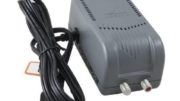Go anywhere around the world and you’ll find plain round satellite dishes like the one above. Those 18″ round dishes went out of fashion here in the US over a decade ago. Other parts of the world seem to still use them. Why is DIRECTV so different?
How “everyone else” does satellite
In most parts of the world there’s no monthly bill for satellite TV. Yes, you read that right. You can put up a dish, buy a receiver and be receiving broadcasts without paying anyone. It sounds like a good deal and for a lot of people it is. However, it’s not truly free.
“Freeview” satellite TV is available in countries where the government operates a lot of the TV channels. These days, it’s easier to lease some space on a satellite and cover your entire country than putting in a network of broadcast towers. So in those countries, people pay taxes which go toward operating satellite capacity.
Freeview satellite is designed to be easy and simple and generally consists of only a few channels. That makes the “round dish” perfect because it’s easy to aim. You only need to point it at one satellite and you’re done.
North and Central America, and Northern Europe
Throughout the western hemisphere and parts of Europe, there are premium satellite services. Not every country even allows companies to charge for satellite TV. In fact the laws in the US needed to be changed so it could be done. However, in those countries, it’s possible to pay a satellite TV provider and get a lot more channels. you know this, of course, because you probably do it.
The biggest provider of satellite TV is of course AT&T, which provides satellite television services to the US and several other countries. They provide more entertainment than anyone else. Shaw, DISH, and SKY operate premium satellite services as well, with Shaw serving Canada, DISH serving the US, and SKY serving Europe.
It’s interesting to not that during the 2000s SKY and DIRECTV were both majority owned by News Corporation, and so they share some common technologies.
Premium satellite TV is more complex
Since you’re paying for satellite TV, you expect more. And with DIRECTV you get more. Instead of a handful of channels, you get thousands, in a mix of standard definition, high definition, and 4K. In order to supply the roughly 10,000 channels that DIRECTV processes, it takes more than one satellite. (Note: You won’t get every one of those channels, as most of them are designated for local use)
At the moment AT&T operates 12 satellites in four primary locations, just for US customers. Other satellites in the fleet serve other countries. Those satellites use several different broadcast technologies and three different sets of frequencies. This makes the whole system very complex.
In order to receive signals from all those satellites at once, you need a bigger dish and a more complicated system. You could actually have a much smaller dish if you were willing to move the dish every time you changed the channel, but most people won’t do that.
DIRECTV satellite technology has evolved to become much more complicated than any other satellite provider in the world, but the impressive part is that it’s still easy for regular folks to use. In order to make that happen, the company developed its own standards and its own hardware. Unfortunately it means DIRECTV equipment can’t be used for any other satellite provider, but it’s a small price to pay for what you get
DIRECTV Satellite is a great value
Everyone talks about streaming today, but if you take a look you’ll notice that your streaming bills are starting to get pretty high. Just Netflix, Hulu, and HBO GO together are close to $50 a month, and that doesn’t count any other channels you may want.
With DIRECTV satellite you not only get great live TV and an industry-leading DVR, you also get access to the streaming versions of practically every channel. Satellite TV actually makes your streaming experience better and it costs less than you think.
If you think DIRECTV Satellite might be right for you, fill out the form below or give a call to Solid Signal at 888-233-7563 and they’ll help you with pricing, packages, and installation!





